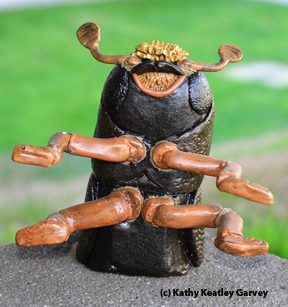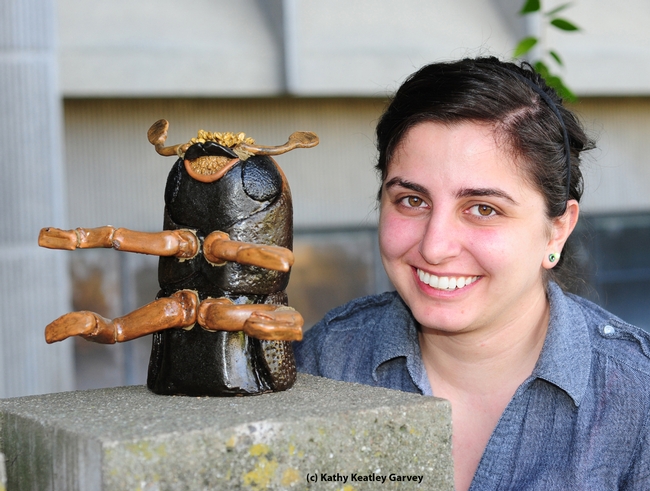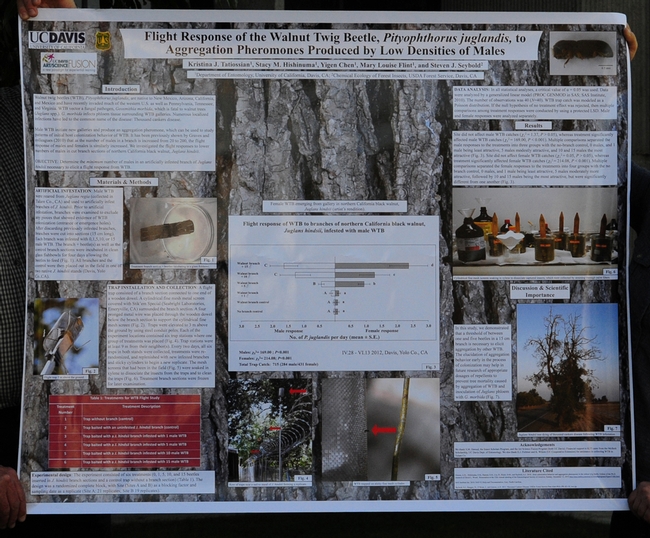
No wonder. The insect, measuring about 1.5 millimeters long, is much smaller than a grain of rice.
Now, however, they can see a teddy-bear-sized version, thanks to a University of California, Davis entomology major Kristina Tatiossian, a member of the Research Scholars Program in Insect Biology.
Through the UC Davis Art/Science Fusion Program, Tatiossian, a junior, crafted a ceramic mosaic sculpture of the tiny walnut twig beetle for her research poster, “Flight Response of the Walnut Twig Beetle, Pityophthorus juglandis, to Aggregation Pheromones Produced by Low Densities of Males.”
The beetle jutting from the poster is so true to form that scientists studying the insect not only readily recognize it, but point out that it’s a female. That includes her mentor, chemical ecologist and forest entomologist Steve Seybold of the Davis-based Pacific Southwest Research Station, USDA Forest Service, and an affiliate of the UC Davis Department of Entomology.
Seybold and Andrew Graves, a former UC Davis researcher with the UC Davis Department of Plant Pathology, who now works for the USDA Forest Service, first detected the newly recognized beetle-fungus disease, known as Thousand Cankers Disease (TCD), in California in 2008. TCD had been detected earlier in Colorado and its impact had been noted even earlier in New Mexico, Oregon, and Utah. TCD and its history are chronicled in a newly revised “Pest Alert” issued by the USDA Forest Service.

Tatiossian accomplished the research project as part of the Research Scholars Program in Insect Biology, which aims to provide undergraduates with a closely mentored research experience in biology. Headed by professor Jay Rosenheim, and assistant professor Louie Yang of the UC Davis Department of Entomology, the program currently has 12 students; students apply when they are freshmen, sophomores or transfer students. Tatiossian joined the program in 2011 and is mentored by Steve Seybold.
Tatiossian completed the ceramic mosaic project over a four-week period. She earlier worked on two UC Davis Art/Science Fusion Program projects, including the “Tree of Life,” with the program’s founders, entomologist/artist Diane Ullman and artist Donna Billick. A former Los Angeles resident, Tatiossian will receive her bachelor’s degree in entomology this June and then plans to attend graduate school to study either biochemistry or virology.

Tatiossian will giving an oral presentation on her research at the Pacific Branch, ESA meeting, set for April 7-10 at South Lake Tahoe. Then she will display the poster again in the Undergraduate Research Conference at UC Davis on April 24 in Wellman Hall.
By itself, the beetle, native to Arizona, California, New Mexico and Mexico, does little or no damage. But when coupled with the newly described fungus, Geosmithia morbida, it is killing thousands of walnut trees.
The disease is creating havoc throughout much of the western United States, Seybold said, and is now heading east. Its primary host is the black walnut tree but it also attacks other walnut trees.

“Male WTB initiate new galleries and produce an aggregation pheromone, which can be used to study patterns of initial host colonization behavior of WTB. It has been previously shown by Graves and colleagues (2010) that as the number of males in a branch is increased from 20 to 200, the flight response of males and females is similarly increased,” she wrote. “We investigated flight responses to lower numbers of males in cut branch sections of northern California black walnut, Juglans hindsii.”
Her objective: “To determine the minimum number of males in an artificially infested branch of Juglans hindsii necessary to elicit a flight response from WTB.” She found that as little as one to five males is enough to elicit the aggregation response at her field study sites at two locations in Davis.
The poster will be displayed on the third floor of Briggs Hall, just outside the Department of Entomology’s administration office.
On her poster, Tatiossian credits Seybold; Extension entomologist Mary Louise Flint, associate director for Urban and Community IPM, UC Statewide Integrated Pest Program; entomology graduate student Stacy Hishinuma, and postdoctoral researcher Yigen Chen of the UC Davis Department of Entomology.
And the UC Davis Art/Science Fusion Program where the tiny walnut twig beetle sprang to life.
Attached Images:

